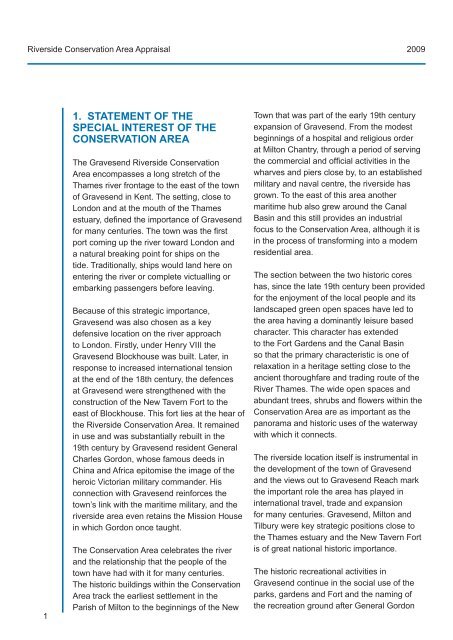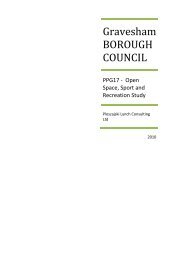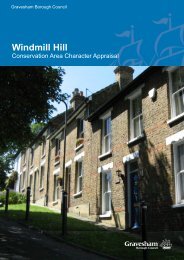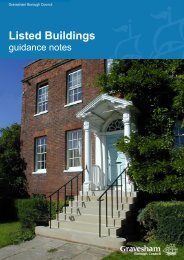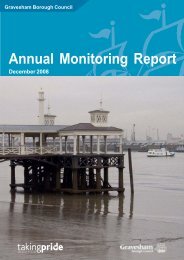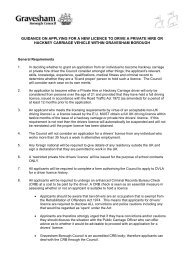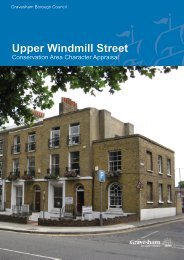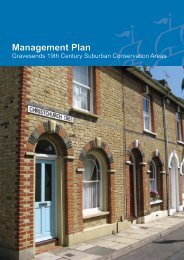gravesend riverside conservation area - Gravesham Borough Council
gravesend riverside conservation area - Gravesham Borough Council
gravesend riverside conservation area - Gravesham Borough Council
You also want an ePaper? Increase the reach of your titles
YUMPU automatically turns print PDFs into web optimized ePapers that Google loves.
Riverside Conservation Area Appraisal 2009<br />
1<br />
1. STATEMENT OF THE<br />
SPECIAL INTEREST OF THE<br />
CONSERVATION AREA<br />
The Gravesend Riverside Conservation<br />
Area encompasses a long stretch of the<br />
Thames river frontage to the east of the town<br />
of Gravesend in Kent. The setting, close to<br />
London and at the mouth of the Thames<br />
estuary, defined the importance of Gravesend<br />
for many centuries. The town was the first<br />
port coming up the river toward London and<br />
a natural breaking point for ships on the<br />
tide. Traditionally, ships would land here on<br />
entering the river or complete victualling or<br />
embarking passengers before leaving.<br />
Because of this strategic importance,<br />
Gravesend was also chosen as a key<br />
defensive location on the river approach<br />
to London. Firstly, under Henry VIII the<br />
Gravesend Blockhouse was built. Later, in<br />
response to increased international tension<br />
at the end of the 18th century, the defences<br />
at Gravesend were strengthened with the<br />
construction of the New Tavern Fort to the<br />
east of Blockhouse. This fort lies at the hear of<br />
the Riverside Conservation Area. It remained<br />
in use and was substantially rebuilt in the<br />
19th century by Gravesend resident General<br />
Charles Gordon, whose famous deeds in<br />
China and Africa epitomise the image of the<br />
heroic Victorian military commander. His<br />
connection with Gravesend reinforces the<br />
town’s link with the maritime military, and the<br />
<strong>riverside</strong> <strong>area</strong> even retains the Mission House<br />
in which Gordon once taught.<br />
The Conservation Area celebrates the river<br />
and the relationship that the people of the<br />
town have had with it for many centuries.<br />
The historic buildings within the Conservation<br />
Area track the earliest settlement in the<br />
Parish of Milton to the beginnings of the New<br />
Town that was part of the early 19th century<br />
expansion of Gravesend. From the modest<br />
beginnings of a hospital and religious order<br />
at Milton Chantry, through a period of serving<br />
the commercial and official activities in the<br />
wharves and piers close by, to an established<br />
military and naval centre, the <strong>riverside</strong> has<br />
grown. To the east of this <strong>area</strong> another<br />
maritime hub also grew around the Canal<br />
Basin and this still provides an industrial<br />
focus to the Conservation Area, although it is<br />
in the process of transforming into a modern<br />
residential <strong>area</strong>.<br />
The section between the two historic cores<br />
has, since the late 19th century been provided<br />
for the enjoyment of the local people and its<br />
landscaped green open spaces have led to<br />
the <strong>area</strong> having a dominantly leisure based<br />
character. This character has extended<br />
to the Fort Gardens and the Canal Basin<br />
so that the primary characteristic is one of<br />
relaxation in a heritage setting close to the<br />
ancient thoroughfare and trading route of the<br />
River Thames. The wide open spaces and<br />
abundant trees, shrubs and flowers within the<br />
Conservation Area are as important as the<br />
panorama and historic uses of the waterway<br />
with which it connects.<br />
The <strong>riverside</strong> location itself is instrumental in<br />
the development of the town of Gravesend<br />
and the views out to Gravesend Reach mark<br />
the important role the <strong>area</strong> has played in<br />
international travel, trade and expansion<br />
for many centuries. Gravesend, Milton and<br />
Tilbury were key strategic positions close to<br />
the Thames estuary and the New Tavern Fort<br />
is of great national historic importance.<br />
The historic recreational activities in<br />
Gravesend continue in the social use of the<br />
parks, gardens and Fort and the naming of<br />
the recreation ground after General Gordon


